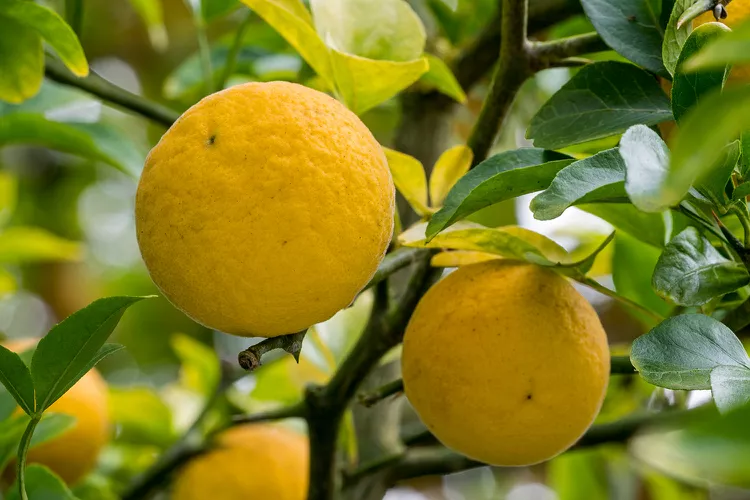Boasting edible fruit and large thorns, trifoliate orange is a hardy citrus for cold regions. This large shrub or small tree is hardy down to Zones 5 and produces sour fruit that is deep yellow and about the size of a golf ball. The fruit has a thick peel and many seeds, and has a flavor that falls somewhere between a lemon and a grapefruit. The fruit ripens in fall and can be juiced for use in beverages. The pulp can be used for jam. Trifoliate orange is a four-season plant. Exceptionally fragrant white flowers in spring are followed by clean, green summer foliage, yellow fall color, and its contorted, slightly twisting branches are eye-catching in winter.
Trifoliate orange can reseed prolifically and invade woodlands, forest edges, fence rows, and urban green spaces. It's classified as an invasive species in Alabama, Georgia, and South Carolina and may not be planted in these states. Trifoliate orange is an identified aggressive species in many nearby states.
Trifoliate orange, hardy orange, bitter orange Overview
| Genus Name | Citrus trifoliata |
| Common Name | Trifoliate orange, hardy orange, bitter orange |
| Plant Type | Fruit, Shrub, Tree |
| Light | Sun |
| Height | 8 to 20 Feet |
| Width | 6 to 15 Feet |
| Flower Color | White |
| Foliage Color | Blue/Green |
| Season Features | Colorful Fall Foliage, Spring Bloom |
| Zones | 5, 6, 7, 8 |
| Propagation | Seed, Stem Cuttings |
Where to Plant Trifoliate Orange
Trifoliate orange is native to China and is thought to have been introduced to North America for use as a barrier plant, especially in agricultural settings. It was planted in hedgerows as a living fence for livestock. It can make an interesting living fence in home landscapes today, but beware of the long, sharp thorns. Avoid planting it where small children or pets may play or near busy walkways. Thanks to its four seasons of interest, trifoliate orange can also make a striking specimen plant in the landscape.
How and When to Plant Trifoliate Orange
Trifoliate orange is difficult to find in nurseries and garden centers. Search out a reputable dealer online. Plant trifoliate orange in spring or early fall. Dig a planting hole just large enough to accommodate the root system. Position the root ball in the planting hole so the root flair is level with the surrounding grade and backfill with soil from the planting hole. Water your newly planted trifoliate orange regularly for the first year after planting. After the plant is established, it will rarely require supplemental watering.
Care Tips
Light
At least 8 hours of bright, direct sunlight is essential for a good fruit set for trifoliate orange. Plants will grow in part shade, but they will produce fewer fruit.
Soil and Water
Trifoliate orange, like most citrus plants, thrives in well-drained soil. It doesn’t tolerate heavy clay or soggy soil. Avoid planting it near areas where water stands after a big rain or places with heavy, hard soil. The best soil for growing trifoliate orange is lightweight, loose, and has a sandy texture. Trifoliate orange generally gets all the water it needs from natural precipitation. It is somewhat drought tolerant and only requires supplement watering during periods of extreme drought.
Temperature and Humidity
Hardy in Zones 5 through 9, trifoliate orange is a unique citrus plant for cold regions. In Zone 5, provide winter protection by planting it on the south side of a building or line of trees. The building or trees will protect the plant from cold, drying north winds.
Fertilizer
Trifoliate orange does not require fertilization. It grows, flowers, and fruits well in native soil if the soil is well-drained.
Pests and Problems
Trifoliate orange has no notable pests or problems.
Pruning Trifoliate Orange
Trifoliate orange grows quickly and benefits from annual pruning. When pruning, wear heavy leather gloves to protect your hands from the sharp thorns. Prune in winter when the plant’s structure is clearly visible. Remove dead, broken, and crossing branches. Trifoliate orange spreads slowly; keep it in bounds by digging up stems that emerge beyond its allotted areas in the landscape as soon as they are noticed.
How to Harvest Trifoliate Orange
Harvest trifoliate orange fruits in fall when they turn deep yellow and have a light citrus fragrance. The fuzzy fruit has a thick rind and is extremely sour. Dispose of fallen fruit to prevent rampant reseeding.
Propagating Trifoliate Orange
Make more trifoliate orange plants by taking stem cuttings and rooting them in moist potting soil. Grow the cuttings in a protected location for several weeks until a strong root system is established. After the root system is established, transplant cuttings into the landscape and water them well. Trifoliate orange can also be started from seed. Plant seeds in moist potting soil and transplant into the garden when they are 6 inches tall.
Types of Trifoliate Orange
‘Flying Dragon’ is a small cultivar compared to the species. It has a shrub-like growth habit and stands 6 feet or so tall and wide. The curling, contorted stems and dense habit make it an excellent barrier plant or hedge. ‘Flying Dragon’ has good fruit production.




















